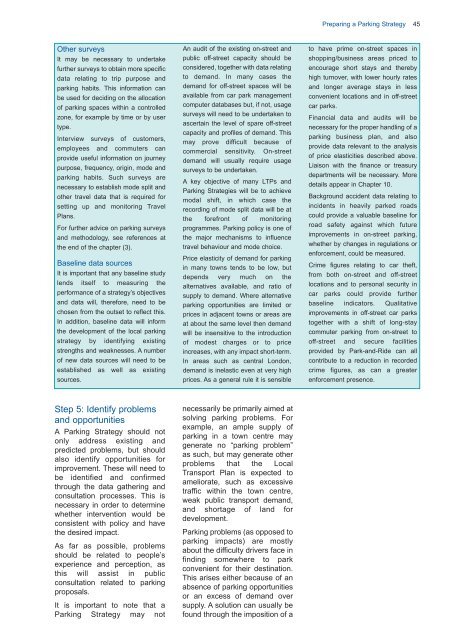titlepage/contents pg 1-16 - British Parking Association
titlepage/contents pg 1-16 - British Parking Association
titlepage/contents pg 1-16 - British Parking Association
Create successful ePaper yourself
Turn your PDF publications into a flip-book with our unique Google optimized e-Paper software.
Preparing a <strong>Parking</strong> Strategy 45Other surveysIt may be necessary to undertakefurther surveys to obtain more specificdata relating to trip purpose andparking habits. This information canbe used for deciding on the allocationof parking spaces within a controlledzone, for example by time or by usertype.Interview surveys of customers,employees and commuters canprovide useful information on journeypurpose, frequency, origin, mode andparking habits. Such surveys arenecessary to establish mode split andother travel data that is required forsetting up and monitoring TravelPlans.For further advice on parking surveysand methodology, see references atthe end of the chapter (3).Baseline data sourcesIt is important that any baseline studylends itself to measuring theperformance of a strategy’s objectivesand data will, therefore, need to bechosen from the outset to reflect this.In addition, baseline data will informthe development of the local parkingstrategy by identifying existingstrengths and weaknesses. A numberof new data sources will need to beestablished as well as existingsources.An audit of the existing on-street andpublic off-street capacity should beconsidered, together with data relatingto demand. In many cases thedemand for off-street spaces will beavailable from car park managementcomputer databases but, if not, usagesurveys will need to be undertaken toascertain the level of spare off-streetcapacity and profiles of demand. Thismay prove difficult because ofcommercial sensitivity. On-streetdemand will usually require usagesurveys to be undertaken.A key objective of many LTPs and<strong>Parking</strong> Strategies will be to achievemodal shift, in which case therecording of mode split data will be atthe forefront of monitoringprogrammes. <strong>Parking</strong> policy is one ofthe major mechanisms to influencetravel behaviour and mode choice.Price elasticity of demand for parkingin many towns tends to be low, butdepends very much on thealternatives available, and ratio ofsupply to demand. Where alternativeparking opportunities are limited orprices in adjacent towns or areas areat about the same level then demandwill be insensitive to the introductionof modest charges or to priceincreases, with any impact short-term.In areas such as central London,demand is inelastic even at very highprices. As a general rule it is sensibleto have prime on-street spaces inshopping/business areas priced toencourage short stays and therebyhigh turnover, with lower hourly ratesand longer average stays in lessconvenient locations and in off-streetcar parks.Financial data and audits will benecessary for the proper handling of aparking business plan, and alsoprovide data relevant to the analysisof price elasticities described above.Liaison with the finance or treasurydepartments will be necessary. Moredetails appear in Chapter 10.Background accident data relating toincidents in heavily parked roadscould provide a valuable baseline forroad safety against which futureimprovements in on-street parking,whether by changes in regulations orenforcement, could be measured.Crime figures relating to car theft,from both on-street and off-streetlocations and to personal security incar parks could provide furtherbaseline indicators. Qualitativeimprovements in off-street car parkstogether with a shift of long-staycommuter parking from on-street tooff-street and secure facilitiesprovided by Park-and-Ride can allcontribute to a reduction in recordedcrime figures, as can a greaterenforcement presence.Step 5: Identify problemsand opportunitiesA <strong>Parking</strong> Strategy should notonly address existing andpredicted problems, but shouldalso identify opportunities forimprovement. These will need tobe identified and confirmedthrough the data gathering andconsultation processes. This isnecessary in order to determinewhether intervention would beconsistent with policy and havethe desired impact.As far as possible, problemsshould be related to people’sexperience and perception, asthis will assist in publicconsultation related to parkingproposals.It is important to note that a<strong>Parking</strong> Strategy may notnecessarily be primarily aimed atsolving parking problems. Forexample, an ample supply ofparking in a town centre maygenerate no “parking problem”as such, but may generate otherproblems that the LocalTransport Plan is expected toameliorate, such as excessivetraffic within the town centre,weak public transport demand,and shortage of land fordevelopment.<strong>Parking</strong> problems (as opposed toparking impacts) are mostlyabout the difficulty drivers face infinding somewhere to parkconvenient for their destination.This arises either because of anabsence of parking opportunitiesor an excess of demand oversupply. A solution can usually befound through the imposition of a







